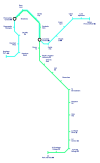PacerTrain142
On Moderation
So for a while now I've thought that it would be a good idea for some lightly used lines to be converted to a light rail system, like the Tyne and Wear Metro, the Manchester Metrolink or maybe even a busway.
There was a thread made recently "Have trains had thier day?" where someone suggested that it would be better to simply convert all trainlines into express busways. However, others were quick to point out that it just wouldn't work for busy/express routes, for example London to Brighton or the East Coast Main Line.
However, for smaller, quieter routes, I think it would be a great idea to convert them to light rail or maybe even a busway. Routes like Preston to Blackpool South/Ormskirk/Colne and Darlington to Bishop Auckland, which until recently, were mostly operated by Class 142 Pacer Trains, which were essentially two Leyland National single decker buses strapped together.
As well as saving money, there are other potential benefits of this idea. The trains on the lines mentioned above are not very frequent, due to fairly low usage and long sections of single track. You could increase the frequency on these routes with a bus or tram to half hourly (or even quarter hourly) which would be less viable with heavy rail. I think for routes like this, I don’t think it would be any slower either due to the fairly low speed limits and the slow acceleration of the diesel sprinter trains that operate these routes. If anything, it might actually be a bit quicker, due to the faster acceleration and better braking ability of buses and trams. Buses can go faster round curves too, whereas trains can only safely go round tight curves at 10-20 mph.
They converted the Oldham Loop in Manchester from heavy rail into a tramway about 15 years ago and it was a big success (having previously been operated by pacer trains with a lot of squealing and bouncing) so I don’t see why other routes can’t do the same.
The farily low speed limits, fairly small distance between stations and the fairly low passenger numbers makes these routes excellent candidates for conversion to busways or light rail.
Also, if the Skipton to Colne line were to be reopened as a tramway or busway, it would provide excellent connections between East Lancashire and West Yorkshire, and it would be a lot cheaper than heavy rail. I bet it would get a lot of usage too.
I have attached a picture of a map I made of how it would work in Lancashire. I added a few extra fictional stations to my local area. I also added a Tyne and Wear Metro style stage fares system.
There was a thread made recently "Have trains had thier day?" where someone suggested that it would be better to simply convert all trainlines into express busways. However, others were quick to point out that it just wouldn't work for busy/express routes, for example London to Brighton or the East Coast Main Line.
Have Trains had their day?
This could sound antagonistic but it’s absolutely not meant to be, Have Trains had their day? I continuously have difficult journeys on the rail network, I see a complex system that is difficult to manage and it seems running them for profit just hasn’t worked? I could be wrong as I am far from...
www.railforums.co.uk
However, for smaller, quieter routes, I think it would be a great idea to convert them to light rail or maybe even a busway. Routes like Preston to Blackpool South/Ormskirk/Colne and Darlington to Bishop Auckland, which until recently, were mostly operated by Class 142 Pacer Trains, which were essentially two Leyland National single decker buses strapped together.
As well as saving money, there are other potential benefits of this idea. The trains on the lines mentioned above are not very frequent, due to fairly low usage and long sections of single track. You could increase the frequency on these routes with a bus or tram to half hourly (or even quarter hourly) which would be less viable with heavy rail. I think for routes like this, I don’t think it would be any slower either due to the fairly low speed limits and the slow acceleration of the diesel sprinter trains that operate these routes. If anything, it might actually be a bit quicker, due to the faster acceleration and better braking ability of buses and trams. Buses can go faster round curves too, whereas trains can only safely go round tight curves at 10-20 mph.
They converted the Oldham Loop in Manchester from heavy rail into a tramway about 15 years ago and it was a big success (having previously been operated by pacer trains with a lot of squealing and bouncing) so I don’t see why other routes can’t do the same.
The farily low speed limits, fairly small distance between stations and the fairly low passenger numbers makes these routes excellent candidates for conversion to busways or light rail.
Also, if the Skipton to Colne line were to be reopened as a tramway or busway, it would provide excellent connections between East Lancashire and West Yorkshire, and it would be a lot cheaper than heavy rail. I bet it would get a lot of usage too.
I have attached a picture of a map I made of how it would work in Lancashire. I added a few extra fictional stations to my local area. I also added a Tyne and Wear Metro style stage fares system.


